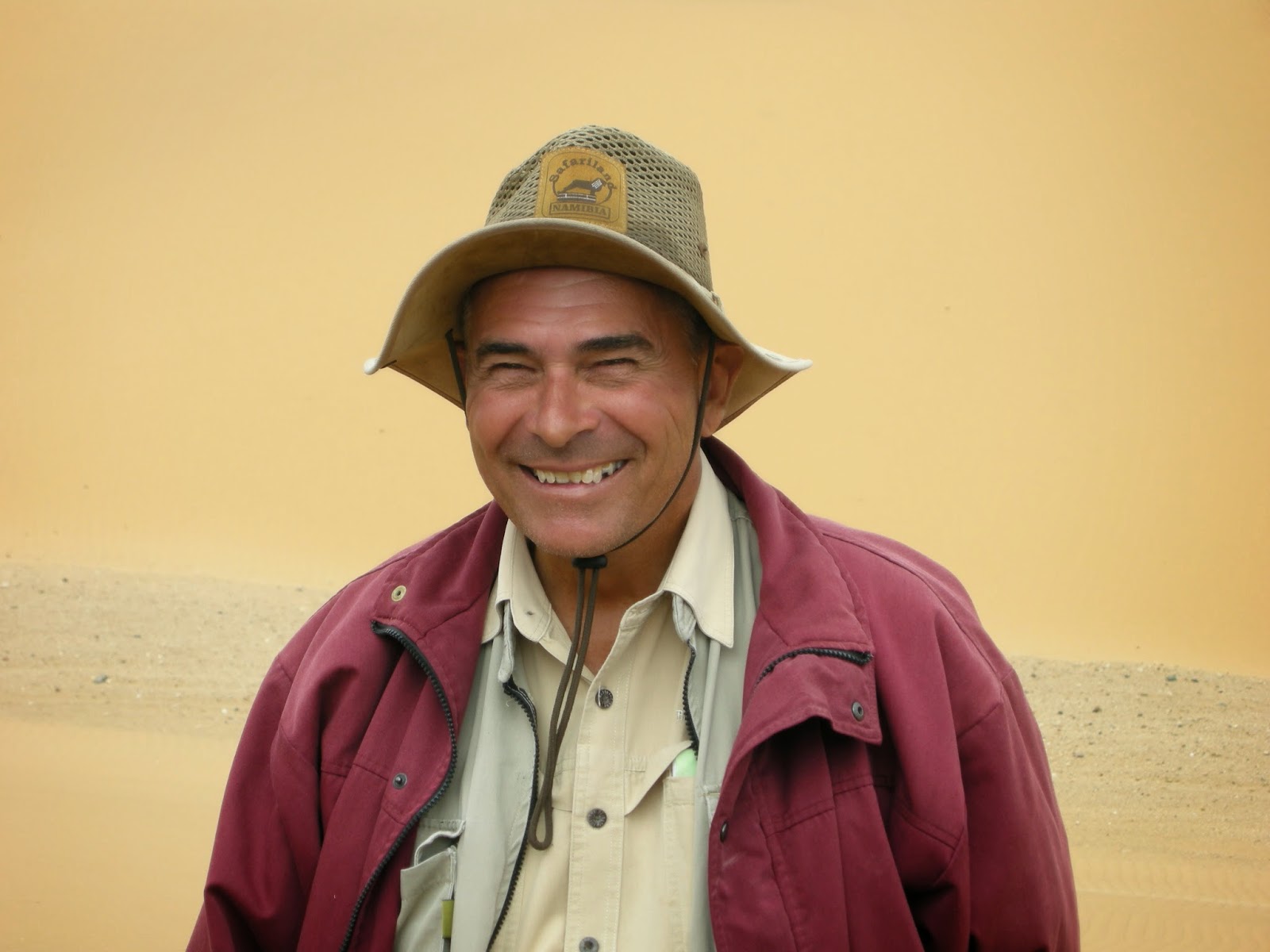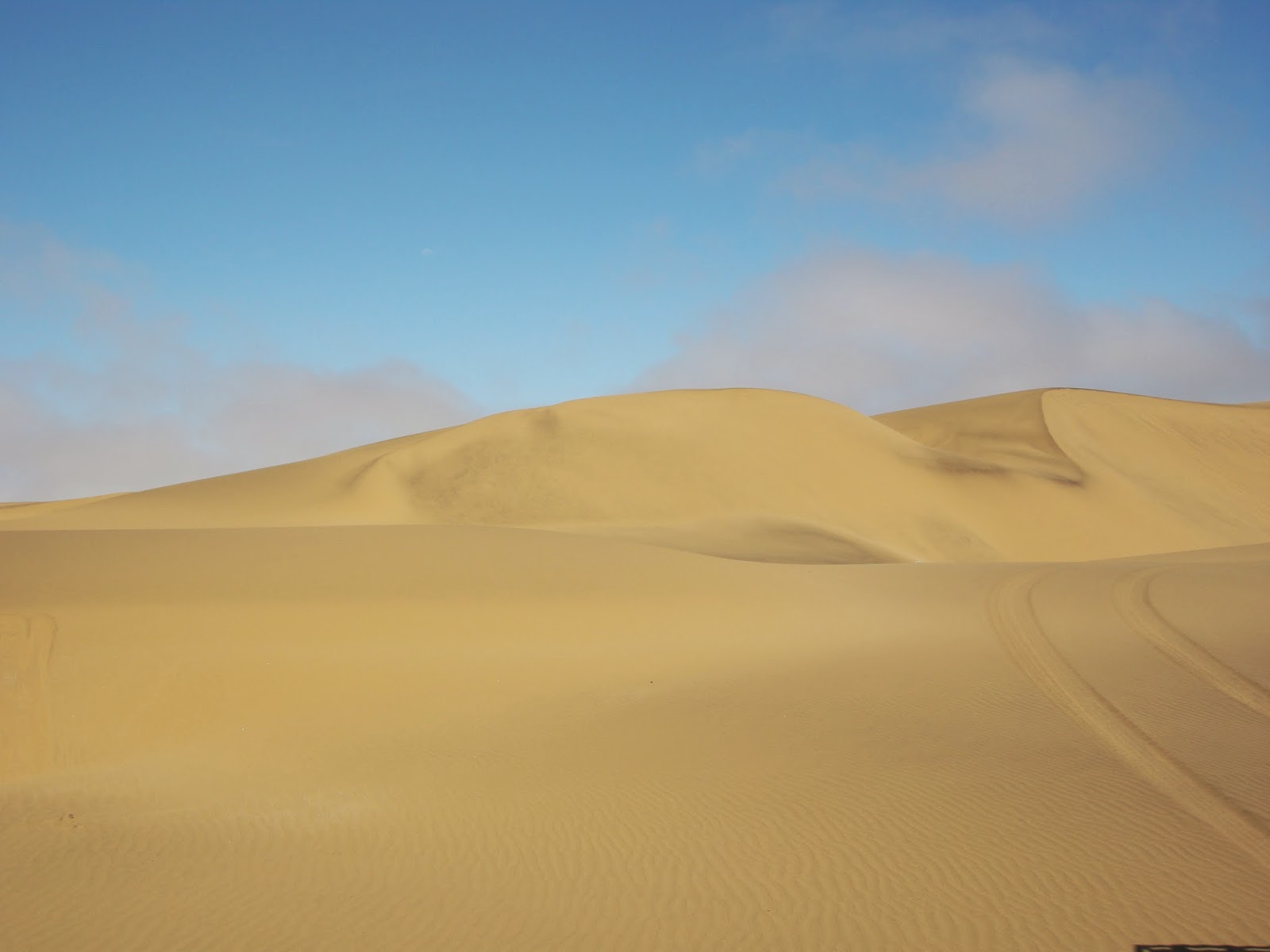NAMIBIA CONTINUED.....................
21 March (Friday) We drove over 850 km from east of Rundu to the Western Coastal city of Swakopmund.
Namibia is a beautiful country! This year the rains have been plentiful. Last year there was no rain at all. The Country was very dry and brown.
Germany "colonized" Namibia in the 1800's. In some areas you will see influences of that time, such as the dress of these Herero ladies.

The tribe's now traditional costumes are seen by anthropologists as a
fascinating subversion of their former rulers' fashion, showing how the tribe
survived a concerted effort by German colonialists to wipe them from the face
of the earth.
The history of Herero clothing is extraordinary. Rhenish missionaries
first introduced Victorian dress, which the tribe gradually accessorised by
adding, for example, cow horn headdresses.
Later, during the 1904 war with Namibia's German colonisers, Herero
tribe members claimed the military uniform of dead German soldiers.
Germany officially claimed their stake in a South African colony in
1884, calling it German South-West Africa until it was taken over in 1915.
 The first German colonists then arrived in 1892, and conflict with the
indigenous Herero and Nama people began.
The first German colonists then arrived in 1892, and conflict with the
indigenous Herero and Nama people began.
Between 1893 and 1903, the Herero and Nama peoples' land as well as
their cattle were seized by militarily superior German forces who regarded them
as subhuman. Then in 1903, the Herero
people learned that they were to be placed in reservations, leaving more room
for colonists to own land and prosper. By
1904, the Herero and Nama began a disastrous rebellion that lasted until 1907.
During this time the Germans devised a plan to annihilate the Herero
nation.
Experts estimate that around 80,000 Herero lived in German South-West
Africa at the beginning of Germany's colonial rule over the area. When the revolt was defeated, they numbered
around 15,000. In a period of four years, approximately 65,000 Herero people
perished. Those who survived, once freed
from concentration camps, were robbed of their lands, segregated from whites
and forced to work in slave-like conditions.
German rule ended in 1915 when the German army was beaten by the South
African - but, once liberated, the Herero men began not only dressing as much
like their German oppressors. Herero women
also affected the styles and the airs and graces of the Christian missionary
ladies who had come among them in the 1890s.
At the 100th anniversary of the massacre, German Minister for Economic
Development and Cooperation Heidemarie Wieczorek-Zeul apologised for the crimes
on behalf of all Germans.
 But the clothes the Herero choose to wear, both men and women, are a permanent
reminder of the great scar gashed in the tribe's history when they came close
to being exterminated. Anthropologist Dr
Lutz Marten said: 'Wearing the enemy's uniform will diminish their power and
transfer some of their strength to the new wearer.
But the clothes the Herero choose to wear, both men and women, are a permanent
reminder of the great scar gashed in the tribe's history when they came close
to being exterminated. Anthropologist Dr
Lutz Marten said: 'Wearing the enemy's uniform will diminish their power and
transfer some of their strength to the new wearer.
'This is in part assimilation to European culture, and also in part
appropriation, a coming-to-terms with, and overcoming of history and the
colonial experience,' he said.
Speaking about the clothes Herero women wear, he said: 'A correctly worn
long dress induces in the wearer a slow and majestic gait.'
Today, there are around 250,000 Herero peoples in south-west Africa
and the tribe is thriving.
As we watched these ladies walk, their movements were very regal!
 |
| I really like the art!!!!! |
We dined
that evening at the Tug restaurant, delicious seafood. We checked into
Voegelstand Guesthouse where we stayed two nights.
22
March (Saturday) We met Johannes, who
works for Tommy, and accompanied them on Tommy’s Deseret Tour. We learned much about Sand Dunes and the
plants and animals that live in the desert.
We then visited Dune # 7, a gigantic Dune by Walvis Bay. That night we dined at the Wreck
Restaurant. (it was not a wreck, we had
delicious seafood again)
 |
| Dune 7 real family fun! |

23
March (Sunday) We attended church at
Swakopmund Group with the Noble Family and Hercules family and two individual
members. Brother Noble is the Group
Leader. The Nobles have a son on a
mission in West Africa. We bore our testimonies, and had part of the time in the third hour to tell about self reliance, and what we do.
Brother
Hercules was a diver for a company seeking treasure in the sea. However, last September, their boat capsized
and some of his ship mates were drowned.
He was miraculously saved, but has had a slow physical recovery and
suffers from Post Traumatic Stress Syndrome.
We journeyed back to Windhoek and the Hotel Alexander. That evening we had dinner with Kenneth
Mofokeng, Humanitarian Project Manager from the Area Office.
#1 Preschool
 24 March (Monday) we accompanied Laura and Josephine from the Namibia Council of Churches and visited Pre schools and Kindergartens. It was a driving rain storm and we were visiting schools in aluminium shacks. Many of the children were in bare feet and the floors were mostly dirt with some old carpet pieces. The Church is considering a project to help with water and toilet facilities.
24 March (Monday) we accompanied Laura and Josephine from the Namibia Council of Churches and visited Pre schools and Kindergartens. It was a driving rain storm and we were visiting schools in aluminium shacks. Many of the children were in bare feet and the floors were mostly dirt with some old carpet pieces. The Church is considering a project to help with water and toilet facilities.
 |
| No toilet facilities. The children just go out in the "bush." one half of the yard is for playing, and one half for pooping. |
 |
| This is the view outside the school. |
 |
| The children sang for us......... |
 |
| The school room walls. |

 |
| You sang for us, I will sing for you. "You Are My Sunshine" is always good! |
# 2 Preschool
 |
| Pieces of carpet cover the dirt floor.... Notice the bucket of water........ |
 |
| The Kitchen |
 |
| Cardboard wall covering...... |
You pay Nam $50.00 ($5.00 US) for a charge on your water card. It allows you to get about 5 gallons a day 5 days a week for 4 weeks. For many it is very expensive. At the first 4 daycares we visited, a five gallon bucket was to last for the whole group for one day. Plus meet the home needs for the preschool owner. Washing, cooking, cleaning, drinking I will never let the water run while I brush my teeth again!!!! I will always keep a pitcher of water cooling in the fridge.
 |
| The water tap. Not only is it expensive, you have to carry it home..... |
#3 Preschool
 |
| A little bit of garden, some tyres to play on. |
 |
A VIP Loo. What a blessing! (Ventilated I is for something Pit) |
#4 Preschool
 |
| Is it nap time, or are we covered up because we are so cold? |
 |
| Adding a flash made a difference! |
 |
| Singing is so fun!!! |

 |
| She also had quite the dance moves!!!! |

 |
| Sorry to leave you in the dark and cold!!! |
 |
| Workers traveling in the rain. |
 |
| Local produce stand. At least 50% is saved by buying off the street instead of in a store. |
 |
| Leaky walls and ceiling? Plastic to the rescue, but it is very dark inside. |
#5 Preschool and Day Care
This is one Day Care that the Namibia Council of Churches has been involved with.
 |
| WATER from a tap!!! |
 |
| A DRINKING FOUNTAIN!!! |
 |
| A FLUSHING TOILET!!!!!!!!! |
 |
| Kitchen with a fridge! |
 |
| "Only Jesus" beautiful song!!! |
 |
| Sister Eggett, Laura, The owner of Omusati and Elder Eggett |
25 March (Tuesday) We met with the Katatura and Windhoek Branch Presidencies and instructed regarding the new PEF Self Reliance Initiative. They were welcoming and already doing much to teach their members Self Reliance. Brother Noble, Group Leader Swakopmund, was also in attendance.
 |
| Katatura Branch Presidency |
 |
| Windhoek Branch Presidency and Brother Noble group leader in Swakopmund |
26 March (Wednesday) We participated in a “hand over” with the National Ministry of Health and Social Services and Dr. Indume and their team with the Eggetts. It is amazing what LDS Charities is doing throughout the world and what couples like the Eggetts are doing here in Africa to meet Humanitarian Needs. We later flew back to Joburg and our friends, Elder and Sister Adams, picked us up at the Airport.
 |
| The Eggetts with the National Minister of Health and Social Services for an official hand over of the eye surgical equipment. |
Back home again to Johannesburg.

 The first German colonists then arrived in 1892, and conflict with the
indigenous Herero and Nama people began.
The first German colonists then arrived in 1892, and conflict with the
indigenous Herero and Nama people began. But the clothes the Herero choose to wear, both men and women, are a permanent
reminder of the great scar gashed in the tribe's history when they came close
to being exterminated. Anthropologist Dr
Lutz Marten said: 'Wearing the enemy's uniform will diminish their power and
transfer some of their strength to the new wearer.
But the clothes the Herero choose to wear, both men and women, are a permanent
reminder of the great scar gashed in the tribe's history when they came close
to being exterminated. Anthropologist Dr
Lutz Marten said: 'Wearing the enemy's uniform will diminish their power and
transfer some of their strength to the new wearer.
























 24 March (Monday) we accompanied Laura and Josephine from the Namibia Council of Churches and visited Pre schools and Kindergartens. It was a driving rain storm and we were visiting schools in aluminium shacks. Many of the children were in bare feet and the floors were mostly dirt with some old carpet pieces. The Church is considering a project to help with water and toilet facilities.
24 March (Monday) we accompanied Laura and Josephine from the Namibia Council of Churches and visited Pre schools and Kindergartens. It was a driving rain storm and we were visiting schools in aluminium shacks. Many of the children were in bare feet and the floors were mostly dirt with some old carpet pieces. The Church is considering a project to help with water and toilet facilities.



























































Mom, the article about the Herero history is so facinating! Thanks for sharing, great writing!
ReplyDelete